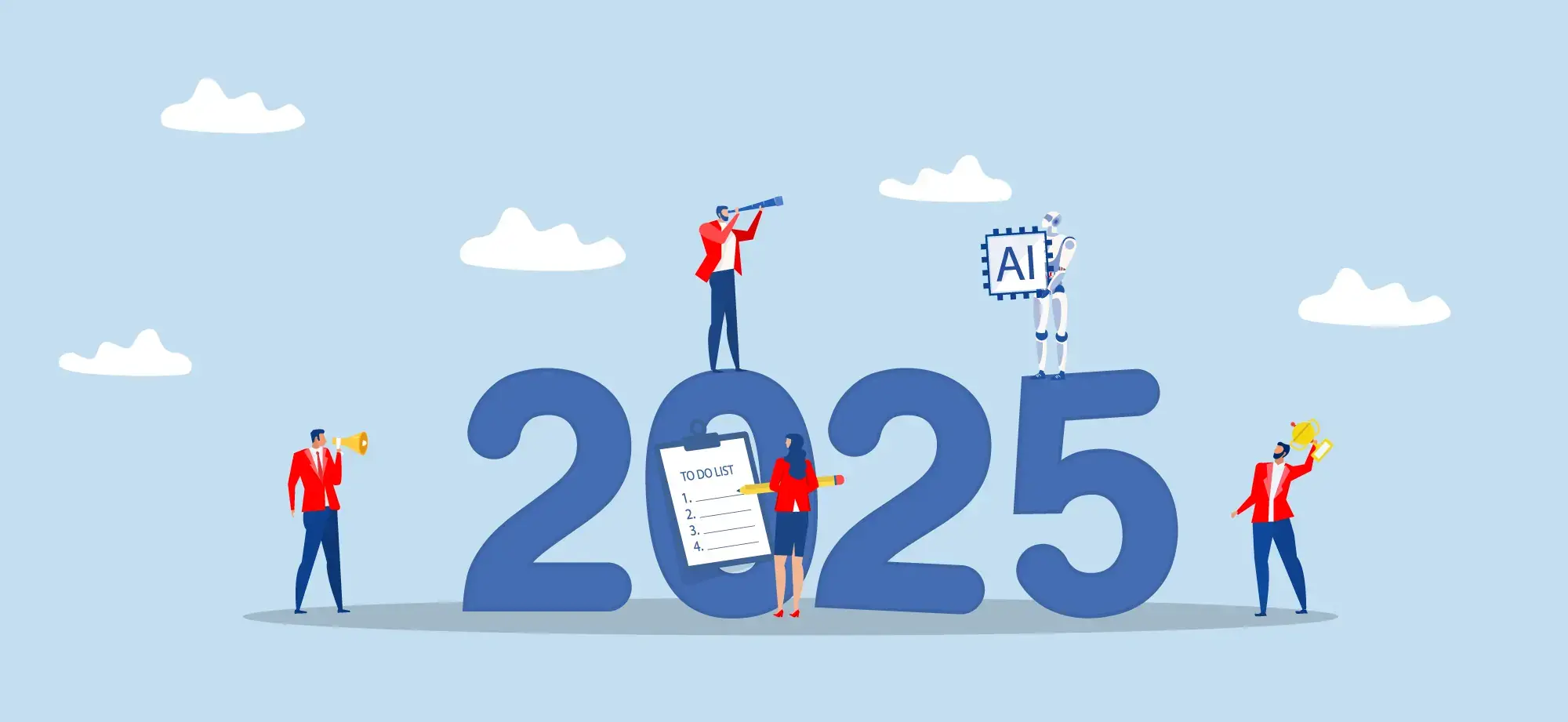AI in the education sector 2025: The practical guide

By Eleonore Schelling • April 15, 2025 • 7 min read
Artificial intelligence (AI) has long been on the strategic agenda. For educational institutions, it is not a question of if, but how to integrate it in a meaningful, ethical and effective way. The use of technology alone is not enough – a clear vision and a well thought-out, practical plan are crucial.
This article highlights specific opportunities, identifies pitfalls and provides you with practical recommendations on how to successfully shape the AI transformation.

SvetaZi / shutterstock
Let's focus on areas where AI can already enable tangible improvements today or in the near future:
Hyper-personalization of learning:
Specifically, adaptive learning platforms (e.g. ALEKS, Pearson (formerly Smart Sparrow technology) or specialized providers) analyze learners' answers in real time, identify gaps in knowledge or special support needs and dynamically adjust the level of difficulty or type of next task. AI can also automatically generate individual exercise plans or suggestions for in-depth resources (videos, articles, simulations) that exactly match the learning profile.
Benefits for decision-makers: More effective targeting of heterogeneous learning groups, potential increase in completion rates, data-based insights into the effectiveness of teaching materials.
Intelligent relief for teachers & staff:
Specifically, in addition to automated assessment (e.g. through tools such as Gradescope or functions integrated into LMS), AI writing assistants (such as Grammarly for Education or ChatGPT Edu) can support teachers/lecturers in the creation of teaching materials, feedback formulation or email communication. AI chatbots (developed with platforms such as Google Dialogflow or specialized edu-chatbot providers) can answer routine student queries on administrative topics (deadlines, registrations, IT support) around the clock.
Latest Research: Language AI Matches Human-Level Communication
A recent study shows that AI-based writing and dialogue systems can hardly be distinguished from real people today: in standardized Turing tests, GPT-4.5 was considered human in 73% of cases – more often than the real interlocutor (Jones & Bergen, 2024). This development shows the potential and responsibility that lies in the use of modern language models - especially in education, where transparency, fairness and contextual understanding are essential.
Benefits for HR & management: Reduction in workload for routine tasks, freeing up capacity for high-quality educational interaction (mentoring, discussions), increasing employee satisfaction and potentially reducing burnout.
Data-driven management & early warning systems:
Specifically, modern learning analytics dashboards, often integrated into leading LMS (such as Canvas or D2L Brightspace) or SIS, use AI to visualize complex data. Predictive analytics tools can identify students who are at high risk of dropping out at an early stage (based on factors such as login frequency, grade development, assignment submissions). This enables targeted support to be offered.
Benefits for decision-makers: More informed strategic planning (e.g. course offerings, staffing requirements), more efficient use of resources, proactive intervention to improve retention rates, improved quality control.
Georgia State University (GSU) implemented an AI-supported early warning system several years ago in response to high drop-out rates, particularly among students from disadvantaged backgrounds. The system analyzes over 800 risk factors based on student data (academic, financial, administrative) and alerts the academic advising team when risks are identified. In addition, an AI chatbot ("Pounce") was introduced to answer thousands of questions from first-year students on topics such as enrollment, financing and course registration.
Result: GSU was able to significantly increase its graduation rates and reduce disparities between different demographic groups. The chatbot answered hundreds of thousands of questions and significantly reduced the workload of advising staff, who can now focus on more complex cases. This example shows how strategically deployed AI can solve concrete problems and achieve measurable success.
Implementing AI is not a sure-fire success. Be prepared for these hurdles and plan proactively:
Technological & financial hurdles:
Specifically: in addition to software costs, consider expenses for cloud infrastructure (e.g. AWS Educate, Azure for Education, Google Cloud for Education), network expansion and possibly new end devices. Integration into existing systems (LMS, SIS) often requires specialized IT expertise or external service providers.
Action: Carry out a thorough needs and infrastructure analysis. Plan budgets for the long term (TCO - Total Cost of Ownership). Check interoperability standards (such as LTI).
Data protection, ethics & transparency:
Specifically, compliance with DSGVO/GDPR (EU) or FERPA (USA) is fundamental. The "black box" problem of many AI models makes it difficult to understand decisions. Clear rules are needed for data use and deletion.
Action: Establish robust data governance guidelines and obtain declarations of consent. Appoint data protection officers with AI expertise. Require transparency reports and Explainable AI (XAI) capabilities from vendors and create an ethics charter for AI use.
Bias and fairness:
Specifically, unbalanced training data can lead to AI tools systematically disadvantaging certain groups (e.g. in speech recognition, assessment or risk prediction).
Action: Question the providers' data basis and algorithms. Carry out diversity audits for AI systems. Include diverse user groups in tests and use bias detection tools if available.
Skills development & change management (HR focus):
Specifically, teachers and staff need more than just a tool introduction. Didactic concepts and further training are just as necessary for dealing critically with AI (what is it good at, what is it not?) as space for exchange and experimentation. Fears must always be taken seriously.
Action (HR & management): Develop a staggered continuing education program (e.g. via platforms such as edX for Business or specialized providers). Encourage a culture of experimentation. Communicate openly about the goals and limits of introducing AI and actively involve staff representatives.
Note: The market for AI tools is extremely dynamic and the tool landscape is changing at a rapid pace. The examples given illustrate typical functions and provide an exemplary overview.

TA Design / shutterstock
Strategic anchoring: Clear, measurable goals for the use of AI that contribute to the institution's overall strategy form the basis. This is supplemented by an AI vision and a roadmap with priorities.
Targeted pilot projects: Start with 1-2 manageable projects where a concrete benefit is recognizable (see HSE example). Success criteria (KPIs) are defined and the effectiveness, user acceptance and ROI are systematically evaluated.
Systematic skills development: Ideally, “AI literacy” is built up through a staged further training program: from basic training to role-specific workshops. Internal multipliers – so-called “AI ambassadors” – can also support the transfer.
Ethical & legal guidelines: Develop clear guidelines on the use of AI, data protection and ethics. For example, guidelines from national education ministries, the German Rectors' Conference or implications of the EU AI Act provide orientation.
Careful partner selection: B2B providers should be put through their paces: Data security, bias mitigation, transparency, support, integration capability and future viability. References in the education sector provide additional clues.
Infrastructure check & planning: Analyze and plan your IT infrastructure (network, cloud, security) with regard to the requirements of AI applications.
AI is a marathon, not a sprint. Educational institutions need a clear strategy, investment and, above all, human-centered implementation. Those who act now will secure a competitive advantage.
As an educational institute with a clear focus on the future, we are following developments in artificial intelligence with great interest - not as a trend, but as a transformative force. We are already making targeted use of AI-supported approaches in curriculum and course development.
At the same time, our internal research group is continuously working on exploring new potential - always with the aim of creating added didactic value and acting in an ethically responsible manner. Because as dynamically as AI continues to develop, it is important to take a considered approach. Our aim is not only to exploit the opportunities offered by AI, but to actively help shape them - in the interests of high-quality, future-proof education.
Sources for the practical example Georgia State University (GSU):
2020 Report – Georgia State University
Leveraging Chatbot Outreach for Improved Course Performance
Student Success through Digital Innovation: A Change Management Model
AI Success Coaching at Georgia State University: Expanding to Persistence
Image Credit for Teaser Image:
Summit Art Creations / shutterstock